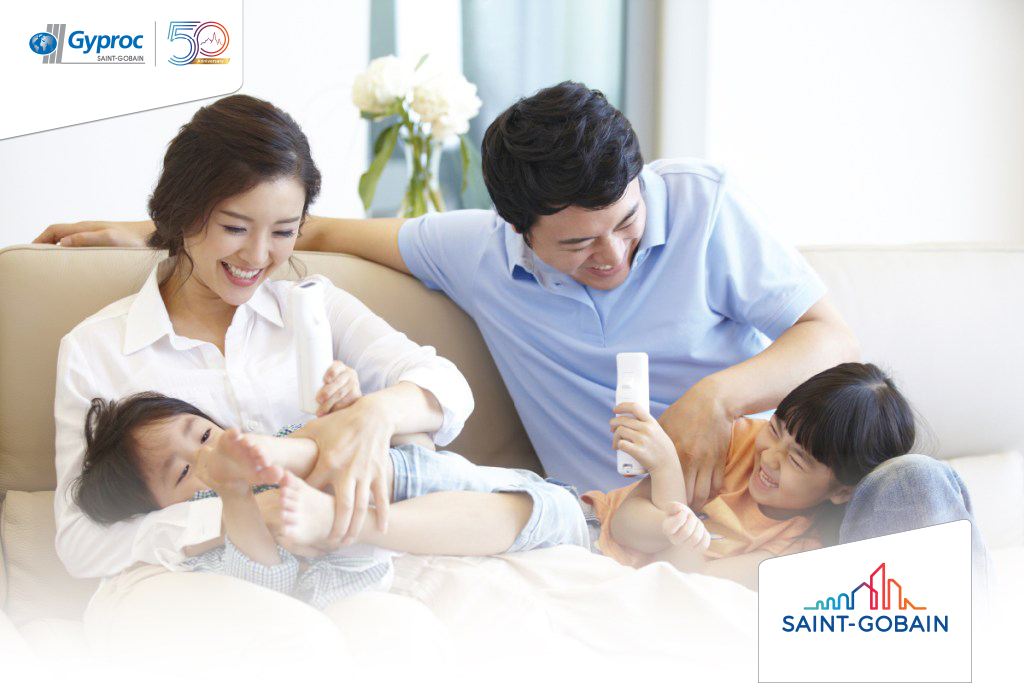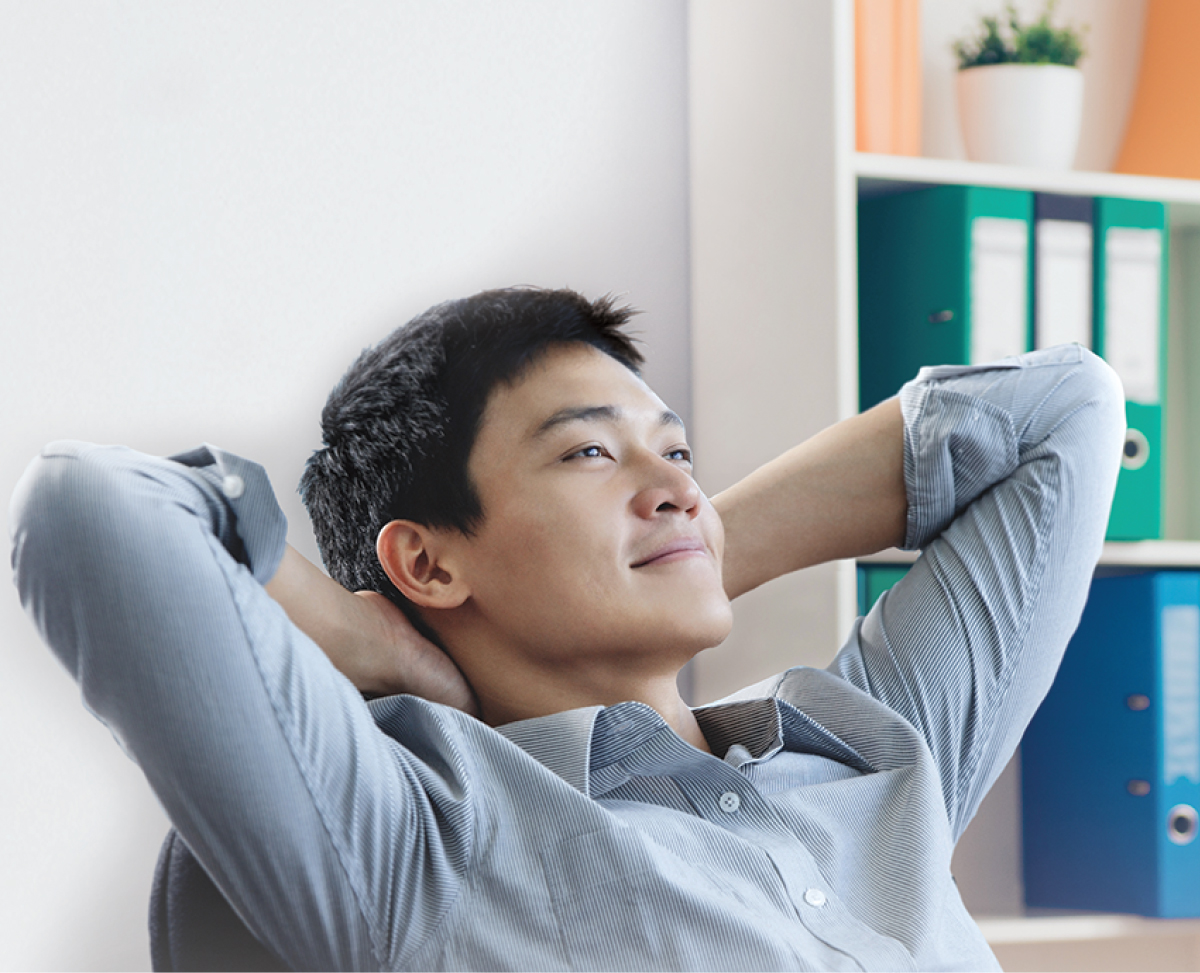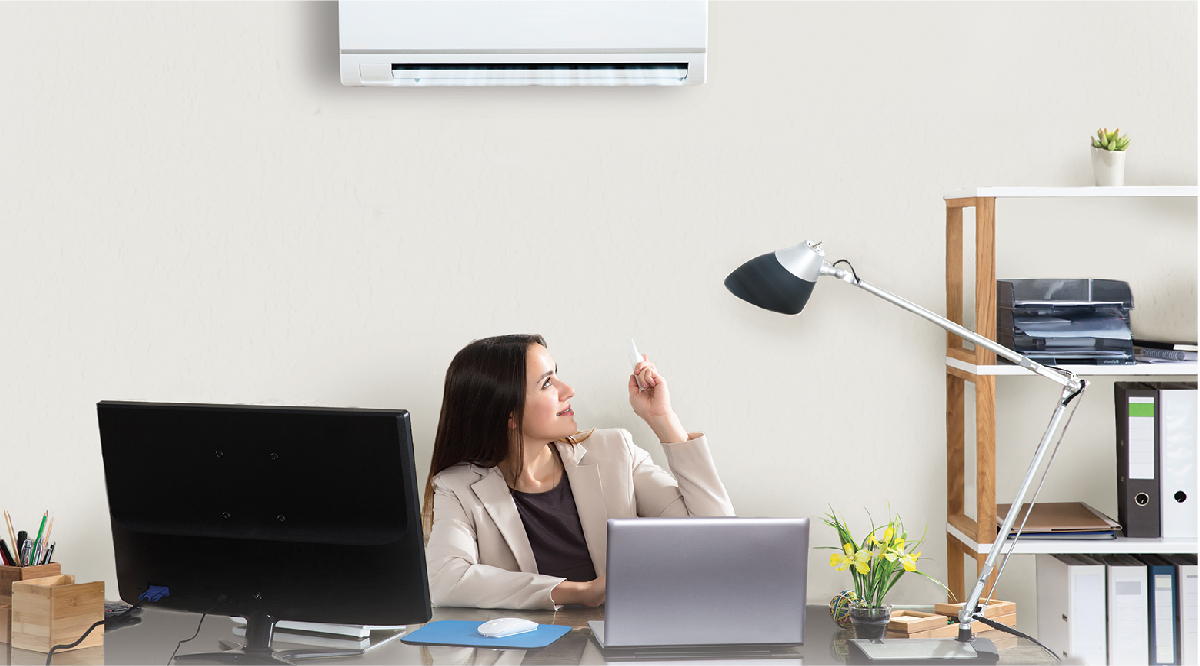The word simply and straightforwardly means a space that makes one feel physically comfortable, which is a rather broad definition. Each and every one of us has our own definition or image of a comfortable space. It may be a home, a favorite resort, a café or even a workplace. Nevertheless, within the context of architecture, there are certain details used to indicate the constituted qualities of thermal comfort.
In general, the criteria of thermal comfort in architecture requires a space to be effectively ventilated with the right amount of humidity and a sufficient presence of natural light. Gyproc brand under Saint-Gobain Group launched its Multi Comfort solution, re-examining the notion of ‘thermal comfort’ on a deeper level; Gyproc’s consideration of thermal comfort doesn’t only encompass comfort in terms of feeling, but also the physical well being of a person who uses a space. Moreover, thermal comfort is not just an alternative addition, but a ‘necessity,’ for each inhabitant possesses his/her own demands.

At the most superficial level such as that of Visual Comfort, Gyproc views that the amount of light in a living space or workspace has a direct effect on human’s emotions and bodily functions in the same way that sleeping does. ‘Thermal Comfort’ deals even more closely with the way a human body feels, and directly involves the role of construction materials such as those used with the building shell. Such materials contribute to the effective filtration of the outside heat and coldness, maintaining a suitable temperature for an interior space. In this sense, the word ‘suitable’ varies for each person. Office workers’ preferred temperature range is between 21 to 23 degrees in order to perform the most efficiently and creatively, whereas the temperature needs to be warmer for children to keep their body from being too cold. The quality of a space also includes Acoustic Comfort, which can be further varied by each user’s activities (some require a very quiet and highly soundproofed area for music practice while some prefer to be completely undisturbed by outside noises to stay full rested over the weekends).

Noise pollution also has a greater effect on inhabitants with research indicating how emotional frustration caused by disturbing noises can have a direct impact on one’s health with headaches and insomnia being some of the discernable symptoms. The whole notion revolving around thermal comfort is the confirmation of the phrase “There’s no one size that fits all” which Gyproc has always upheld. It also paints a better picture of how important it is to choose the right construction materials to attain the most suitable environment for a space while accommodating the diversity of users’ activities.

The control of the temperature is directly related to the amount of energy a space consumes (simply speaking, a lowered electric bill), while the level of the temperature itself affects a space’s indoor air comfort. The fact that we breathe in 12,000 liters of air into our lungs every day, and we spend more time indoors than outdoors, means that the control of ventilation and humidity is highly crucial. There are different sources of unpleasant smells in an enclosed space, from body odor from humans and pets to industrially produced furniture. While there hasn’t been any tangible evidence on how unpleasant smells affect one’s physical well being, the emotional irritation they create is just as hazardous for it can potentially have an impact on a person’s relationship with others.

หลายคนคงเคยสงสัยว่า ‘ภาวะน่าสบาย’ ที่พูดๆ กันตามนิตยสารออกแบบมันคืออะไรกันแน่ อันที่จริงคำนี้มีความหมายง่ายๆ ตรงๆ ว่า พื้นที่ที่เราอยู่แล้วรู้สึกสบาย ซึ่งเป็นความหมายที่ค่อนข้างกว้างทีเดียว เชื่อว่าทุกคนคงมีภาพพื้นที่ที่ “อยู่แล้วสบาย” แตกต่างกันไป ไม่ว่าจะเป็นบ้านพักอาศัย รีสอร์ตที่ชื่นชอบ ร้านกาแฟ ไปจนถึงที่ทำงาน อย่างไรก็ตามในบริบทของสถาปัตยกรรมนั้น ก็มีรายละเอียดที่ระบุว่า “ภาวะน่าสบาย” ที่ว่านี้จำเป็นต้องมีคุณสมบัติอะไรบ้าง
ภาวะน่าสบายในบริบทสถาปัตยกรรมทั่วไปมีหลักเกณฑ์คือ ต้องเป็นพื้นที่ที่อากาศถ่ายเทสะดวก มีความชื้นที่พอเหมาะ รวมไปถึงการมีแสงธรรมชาติที่เพียงพอ อย่างไรก็ตาม แบรนด์ยิปรอคภายใต้กลุ่มธุรกิจแซง-โกแบ็ง ก็ได้เปิดตัวโซลูชั่น Multi Comfort ที่นำประเด็นเรื่อง “ภาวะน่าสบาย” กลับมาพูดถึงอีกครั้งและลึกลงไปมากกว่าเดิม การคำนึงถึงภาวะน่าสบายของยิปรอค ครั้งนี้ไม่ได้พูดถึงความสบายในระดับที่รู้สึกได้แต่คำถึงเรื่องสุขภาพด้วย อีกทั้งยังไม่ได้มองว่าสภาวะน่าสบายเป็นสิ่งที่อาจจะไม่ต้องมีก็ได้ (แต่ถ้ามีก็ดี) แต่เป็นสิ่งที่ “จำเป็น” ต้องมีเพราะความต้องการของผู้อยู่อาศัยแต่ละคนนั้นแตกต่างกัน
เริ่มจากในระดับที่ผิวเผินที่สุดอย่างระดับสายตา (Visual Comfort) ยิปรอคมองว่าปริมาณแสงในพื้นที่อาศัยหรือพื้นที่ทำงานนั้นส่งผลโดยตรงกับอารมณ์และการทำงานของร่างกายเช่นเดียวกันกับการนอนหลับพักผ่อน ถัดมาในหัวข้อ Thermal Comfort เป็นเรื่องของความรู้สึกของร่ายกาย หัวข้อนี้เกี่ยวข้องกับวัสดุก่อสร้างอาคารโดยตรง นั่นคือวัสดุห่อหุ้มอาคารที่มีส่วนสำคัญในการช่วยกรองความร้อน / ความเย็นจากภายนอกให้เข้ามายังพื้นที่ภายในในปริมาณที่พอเหมาะ ซึ่งคำว่า “พอเหมาะ” ที่ว่าของแต่ละคนก็แตกต่างกันไปเสียด้วย พนักงานออฟฟิศต้องการอุณหภูมิที่ 21-23 องศา เพื่อประสิทธิภาพในการคิดงาน ตรงกันข้ามกับเด็กๆ ที่ต้องการอุณหภูมิที่อุ่นขึ้นมาเพื่อให้ร่างกายไม่เย็นเกินไปจนเป็นไข้เอา คุณภาพชีวิตในห้องยังรวมไปถึงความสงบปราศจากเสียงรบกวน (Acoustic Comfort) นอกจากกิจกรรมที่แตกต่างกันไปของผู้อยู่อาศัย (บางคนต้องการห้องที่เงียบและเก็บเสียงมากๆ สำหรับการซ้อมดนตรี บางคนต้องการความเงียบสงบปราศจากเสียงรบกวนจากภายนอกในการพักผ่อนในวันหยุด) เสียงรบกวนยังส่งผลต่อผู้อยู่อาศัยมากกว่านั้น มีผลการวิจัยออกมาแล้วว่า อารมณ์หงุดหงิดที่เกิดจากเสียงรบกวนส่งผลต่อสุขภาพโดยตรง ที่เห็นชัดๆ คืออาการปวดหัว นอนไม่หลับ รวมไปถึงเป็นต้นกำเนิดของความเครียดสะสมอีกด้วย เรื่องที่กล่าวมานี้เองที่ยืนยันว่าวลี “There’re no one size fit all” ที่ยิปรอคยึดถือมีน้ำหนักขึ้นมา และน่าจะทำให้เราเห็นความสำคัญของการเลือกวัสดุก่อสร้างที่ช่วยช่วยปรับสภาพแวดล้อมภายในพื้นที่ให้สมบูรณ์และเหมาะสมกับกิจกรรมต่างๆ
นอกจากการควบคุมอุณหภูมิจะสัมพันธ์โดยตรงกับการปริมาณการใช้พลังงานของพื้นที่แล้ว (พูดง่ายๆ คือช่วยลดค่าไฟ) อุณหภูมิยังสัมพันธ์กับความชื้นของห้องและยังส่งผลต่อกลิ่นไปอีกทอดหนึ่ง (Indoor Air Comfort) ด้วยความที่มนุษย์หายใจเอาอากาศเข้าไปในปอดเฉลี่ยวันละ 12,000 ลิตร ต่อวัน และด้วยความที่เราใช้ชีวิตอยู่ในพื้นที่ indoor มากกว่า outdoor การควบคุมการไหลเวียนอากาศภายในพื้นที่ และความชื้นจึงมีความสำคัญ ต้นกำเนิดกลิ่นในพื้นที่ปิดเกิดได้จากหลายสาเหตุ ทั้งจากคน สัตว์เลี้ยงไปจนถึงเฟอร์นิเจอร์ที่ถูกผลิตขึ้นมาในระบบอุตสาหกรรม ถึงแม้ว่าในปัจจุบันยังไม่มีผลสำรวจว่ากลิ่นไม่พึงประสงค์นั้นส่งผลต่อสุขภาพของเราๆ อย่างไร แต่อย่างน้อยที่สุด ที่แน่ๆ มันก็ส่งผลต่ออารมณ์ซึ่งเป็นเรื่องร้ายแรงไม่แพ้กัน เพราะมันกระทบกับความสัมพันธ์กับคนรอบข้างคุณ
อันที่จริงมันก็เป็นเรื่องดีที่คนไทยมีนิสัยพร้อมจะปรับตัวให้เข้ากับสภาพแวดล้อมรอบกายได้ตลอดเวลา ไม่ว่าจะเป็นในระดับเมือง อย่างระบบขนส่งมวลชนที่ไม่สะดวกสบายหรือโครงสร้างพื้นฐานฟุตบาตหรือถนนหนทางที่เป็นหลุมเป็นบ่อ แต่ในส่วนที่เราควบคุมได้อย่างพื้นที่อาศัย / ทำงาน เราคิดว่าถ้าปัจจุบันมีวิธีการดีๆ ที่ช่วยยกระดับชีวิตของเราได้ มันก็น่าจะเป็นเรื่องดี และเป็นเรื่องสมควรที่เราจะนำนวัตกรรมทางการก่อสร้างใหม่ๆ มาปรับใช้กับบ้านของเราไม่ใช่หรือ? อ่านรายละเอียดของโซลูชั่น Multi Comfort และโปรดักท์ยิปซัมหลากหลายแอพพลิเคชั่นจากแบรนด์ยิปรอคภายใต้กลุ่มธุรกิจแซง-โกแบ็ง เพิ่มเติมได้ที่ https://www.gyproc.co.th/th/
TEXT : NAPAT CHARITBUTRA
PHOTO COURTESY OF GYPROC
gyproc.co.th/th/4MULTICOMFORT

